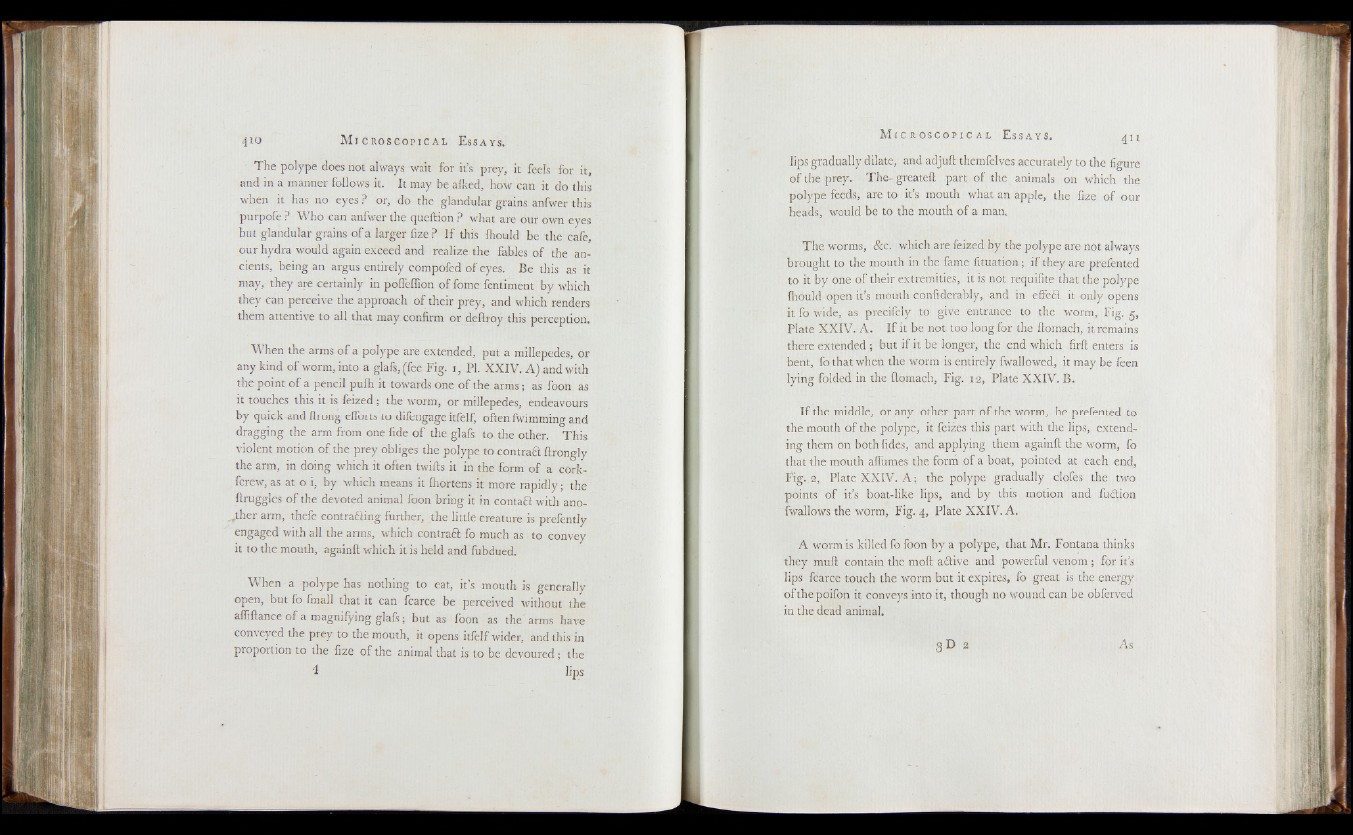
M icroscopical Essays,
The polype does not always wait for it’s prey, it feels for it,
and in a manner follows it. It may be afked, how can it do this
when it has no eyes ? or, do the glandular grains anfwer this
purpofe P Who can anfwer the queftion ? what are our own eyes
but glandular grains of a larger fize ? I f this fhould be the cafe,
our hydra would again exceed and realize the fables of the ancients,
being an argus entirely compofed o f eyes. Be this as it
may, they are certainly in polMion o f fome fentiment by which
they can perceive the approach of their prey, and which renders
them attentive to all that may confirm or deftroy this perception.
When the arms o f a polype are extended, put a millepedes, or
any kind of worm, into a glafs, (fee Fig. 1, PI. XXIV. A) and with
the point o f a pencil pufh it towards one o f the arms; as foon as
it touches this it is feized ; the worm, or millepedes, endeavours
by quick and ftrong efforts to difengage itfelf, often fwimming and
dragging the arm from one fide o f the glafs to the other. This
violent motion of the prey obliges the polype to contraft ftrongly
the arm, in doing which it often twills it in the form of a cork-
fcrew, as at o i, by which means it Ihortens it more rapidly; the
flruggles o f the devoted animal foon bring it in contaft with anoth
e r arm, thefe contracting further, the little creature is prefently
engaged with all the arms, which contraft fo much as to convey
it to the mouth, againft which it is held and fubdued.
When a polype has nothing to eat, it’s mouth is generally
open, but fo fmall that it can fcarce be perceived without the
affiflance o f a magnifying glafs; but as foon as the' arms have
conveyed the prey to the mouth, it opens itfelf wider, and this-in
proportion to the fize of the animal that is to be devoured; the
4 lips
Mi c r o s c o p i c a l Ess ays . 411
lips gradually dilate, and adjuft themfelves accurately to the figure
of the prey. The- greatefl part o f the animals on which the
polype feeds, are to it’s mouth what an apple, the fize of our
heads, would be to the mouth of a man.
The worms, &c. which are feized by the polype are not always
brought to the mouth in the fame fituation ; if they are prefented
to it by one o f their extremities, it is not requifite that the polype
fhould open it’s mouth confiderably, and in effeft it only opens
it fo wide, as precifely to give entrance to the worm, Fig. 5,
Plate XXIV. A. If it be not too long for the flomach, it remains
there extended ; but if it be longer, the end which firfl enters is
bent, fo that when the worm is entirely fwallowed, it may be feen
lying folded in the flomach, Fig. 12, Plate XXIV. B.
I f the middle, or any other part o f the worm, be prefented to
the mouth of the polype, it feizes this part with the lips, extending
them on both fides, and applying them againfl the worm, fo
that the mouth afl'umes the form of a boat, pointed at each end,
Fig. 2, Plate XXIV. A ; the polype gradually clofes the two
points o f it’s boat-like lips, and by this motion and fudlion
fwallows the worm, Fig. 4, Plate XXIV. A.
A worm is killed fo foon by a polype, that Mr, Fontana thinks
they muft contain the moll a Clive and powerful venom ; for it’s
lips fcarce touch the worm but it expires, fo great is the energy
o f the poifon it conveys into it, though no wound can be obferved
in the dead animal.
3 d 2 As